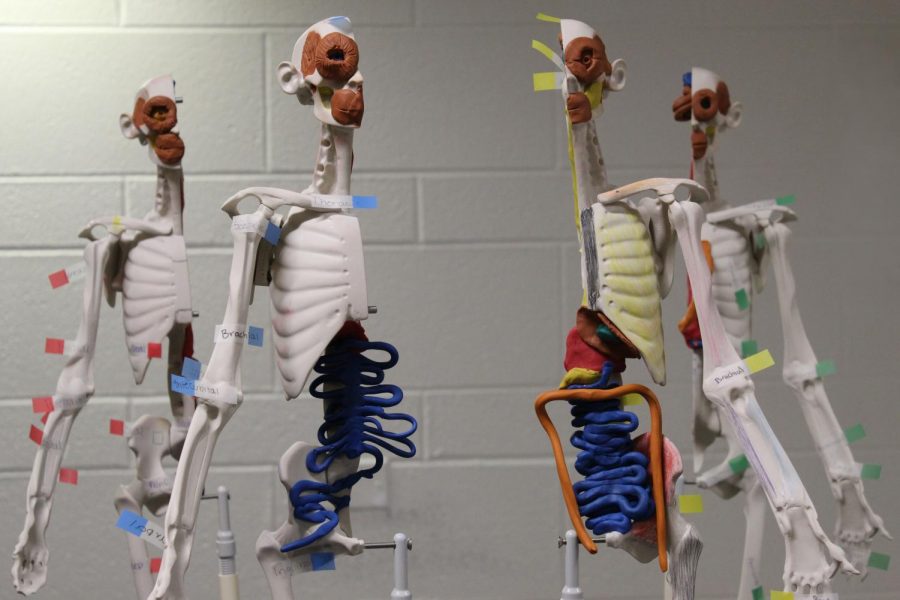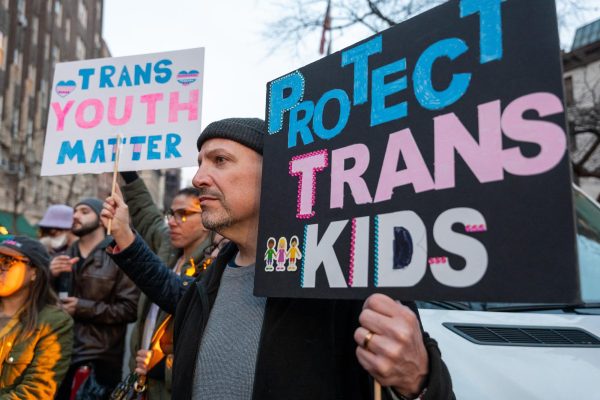Opinion: Abstinence only does more harm than good
Sex education may be good for high school students, but this does not mean it is perfect
Student-constructed models stand tall in a West Campus biology classroom. Health classes in Illinois and across the country spent more time talking about about the body than safe ways to have sex.
December 18, 2019
The Birds and The Bees has always been a prevalent idea in our society, and for good reason. As early as 1912, the National Education Association called for there to be more accessible sexuality education in schools. However, it was not until the 1960s that American schools began to bring the topic of sex into classrooms. Although sex education has come a long way since the early years, it cannot be argued that current American sex education is comprehensive enough.
In America, abstinence-only education comprises more than 20% of the style of sex-education being taught today. Unlike in more comprehensive classes, abstinence-only education tends to not include information on ¨birth control, abortion, obtaining contraceptive and sexually transmitted diseases services, and sexual orientation.” These topics are waived off as unnecessary, as the person will just be practicing abstinence anyways.
However, when considering that, according to the Centers for Disease Control and Prevention, 47% of all American high-schoolers report having had sex, and 15% of American high schoolers report having had four or more partners in their lifetime, it’s obvious to see that kids are having sex nonetheless.
Because of Illinois’s laws, it is required that “abstinence is stressed” as the best option for teens, although West PE teacher Beerbower says that schools can choose to include more comprehensive info. “As we are a public high school,” he says, “catering to 1,300 families, we try to not include information that could cause an upset or controversy.”
When speaking with students about this subject, it was clear that many didn’t realize that at the time of their freshman year health class that this was the only form of sex education that they would receive. “There was barely any talk about contraception and birth control,” junior Greyson Siminak states. “We didn’t cover gay people, and they barely talked about sex at all. It shouldn’t be beaten around the bush. I have learned more on the internet than I have in any health class.”
Studies have shown that teens living in states where abstinence-based education is mandatory have higher rates of pregnancy. Teenage pregnancy is a difficult and emotionally harrowing situation to deal with, and for good reason. It can be financially distressing, socially isolating, and emotionally taxing. It can also contribute to stereotypes, and unfairly affect minorities. ¨Among Hispanic/Latina teen girls in the United States, 53% get pregnant at least once before the age of 20¨, according to the National Campaign. Among African American teen girls, the figure is 51%; for white, non-Hispanic teens, it’s 19%. Obviously, this is an unnerving figure. There have been many testimonies where young girls explain that they went through with the pregnancy, but were not able to continue their education afterwards. This is a contributor to the continuation of families born from teen moms, as it has been shown that teen moms are more likely to have children who grow up to be teen moms. So, this shows that the education of teens leads to the education of generations afterward. Places like Sweden understand this, where only 5 in every 1,000 teens becomes pregnant, compared to 300 in every 1,000 in America.
However, even more comprehensive styles of sex education in America still often have areas where they lack information on important subjects. An example of this is how in only 33 states, and the District of Columbia, students are required to receive instruction on HIV/Aids, among other STDs. Additionally, only 20 of those 33 states have laws set in place stating that the information given must be medically and factually accurate. Also, in 2014, fewer than half of high schools and only 20% of middle schools provided instruction on all 16 topics that the CDC considers essential to sexual health education.
A common opinion among educator’s is that it is not the school’s responsibility to teach students about these subjects, as we are a “public high school”. However, the job of a high school is to properly educate and prepare it’s students nonetheless. Assuming that a student will be informed on everything that is deemed “unnecessary” to teach, when in actuality they are unable to receive this information, continues a pattern of a lack of knowledge. Additionally, teaching students in a school environment allows teens to be taught in a judgement-free, supportive environment, as well as a more professional environment than one that may be provided at home or on the internet.
Some may say that further informing students on this matter is pointless as they will make bad decisions anyway. When talking to a health educator from MCHS, he cited the apparent failure of the anti-vaping campaign as evidence that further information does not affect the levels of teens making bad decisions. But, it has been shown time and time again that the better educated a person is, the more-informed decisions they can make. Providing comprehensive sex education allows Illinois high schools to know that when it comes to the health of their students, they did all that they could.
Overall, the idea of bettering America’s sexual-education system is done with the good of teen’s social, emotional, and physical health in mind. When viewed for what it is, there is no arguing that the addition of certain topics and subjects to current sexual-health standards isn’t beneficial. Once we accept this fact, we can continue on with arguing that America ́s sexual education system is comprehensive enough.























